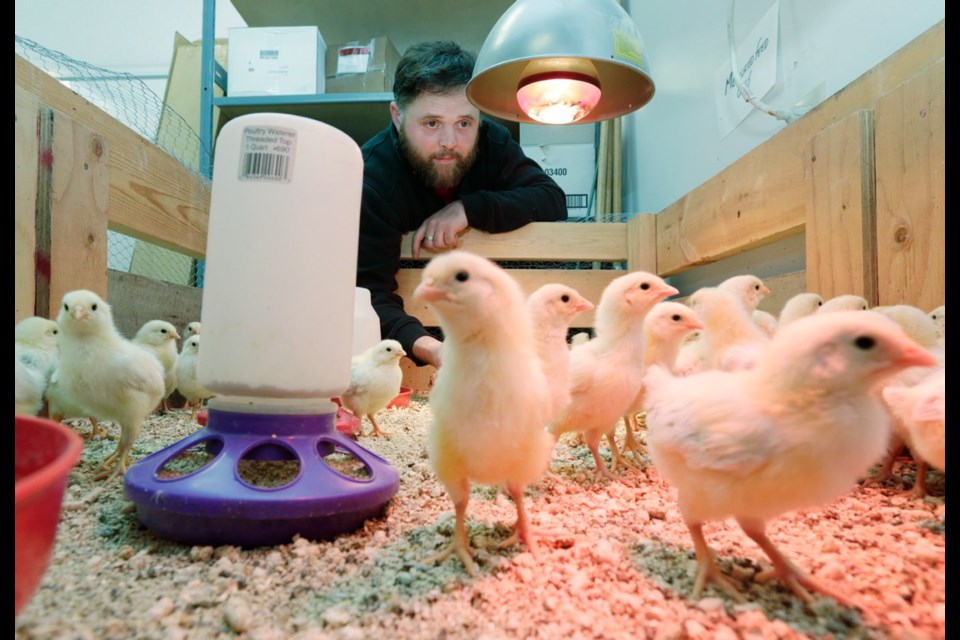Newly hatched spring chicks continue to spark urban action as fledgling entrepreneurs and established businesses supply growing numbers of backyard farmers.
Travis Young, manager of agricultural supply store Buckerfield’s in Central Saanich, said the last couple of years have brought a “big upward trend in backyard poultry. “A lot of municipalities are opening up the bylaws to make it easier and more friendly for people to have four or six chickens,” he said.
Buckerfield’s takes orders for sexed chicks (no urban roosters, thank you) and usually has some on hand from March through to early summer, Young said. The little yellow chicks cost $3 to $4 each, depending on the breed.
Urbanites like having their own chickens for a number of reasons.
Some buy them as a family project and enjoy eggs with deep-yellow yolks. There’s increasing interest in locally produced food and sustainability. Chickens will also happily consume most veggies and produce a bunch of good fertilizer.
Buckerfield’s will help newcomers understand what’s required to care for chickens, Young said.
Coop kits, for assembling at home, cost $300 to $400 Someone wanting to make their own could spend about $200 or more on materials, he said.
A heat lamp for new chicks costs about $30 and prices vary for watering devices and feeders.
Buckerfield’s is hosting a poultry swap from 10 a.m. to 2 p.m. on Sunday in its parking lot. The swaps will be held on the second Sunday in May and June. All ages show up to buy and check out the birds. “It’s fun,” Young said.
Local poultry owners bring everything from chickens and turkeys to quail, ducks and peacocks. It’s never the same. Vendors hand out Buckerfield’s coupons for 12 per cent off poultry supplies or $1 off a bag of feed.
The passion for backyard poultry prompted Shawnigan Lake carpenter Chase Robertson, 27, to join forces with childhood pal Mike Leneghan, 26, president of the Esquimalt Community Gardens Society, to create and market a chicken tractor, which is a moveable chicken coop. Like a wheelbarrow, it has one wheel. “It’s very easy to move,” Robertson said.
They built their first in the fall and are now filling orders. The chicken tractor can be ordered online at www.getcoopedup.com. Their company, Cooped-Up!, will also be at the Moss Street Market, running Saturdays from May to October at Ecole Sir James Douglas School.
Built from either spruce ($400) or cedar ($475), the Cooped-Up! chicken house has room for four birds, Robertson said. Based on an isosceles triangle, it covers a four-foot by eight-foot area. It does not have a floor, allowing chickens to peck grass or other ground.
An interior ramp leads to an upper-level shared nesting box and a roosting area. “They all sit up there, especially in the winter they like to be nice and close,” Robertson said.
A floor mat on the upper level slides out for cleaning and the roof is hinged for easy access to eggs.
The tractors are designed to fold and fit in the back of a pickup truck, Robertson said.
Municipalities regulate backyard chickens and where coops can be located on properties.
When it comes to urban chickens, only hens are welcome.
In the core, Saanich requires flocks on a single family-zoned property to be registered. Chickens are allowed on a single-family lot, provided it is at least 6,000 square feet. Flocks can be up to five or 10 chickens depending on the property size. Check www.saanich.ca
Esquimalt allows residents up to four hens.
The City of Victoria does not limit on the number of hens, but the flock must be consistent with personal use, said Victoria Animal Controls Services. Information for some municipalities is at www.vacs.ca
Victorians can keep ducks, geese, turkey and other poultry, Animal Controls Services said. “If you are serious about keeping chickens, do yourself a big favour and build yourself a decent chicken coop. If you can’t conveniently enter the coop, you will be less likely to clean it. Dirty chicken coops generate complaints: odor, flies, rats, and disease,” the vacs.ca website says.
“Don’t build a chicken coop out of three sheets of plywood and a hockey net unless you want to meet an animal control officer. Chickens are smart and it won’t take them long to find a way out.”
In Oak Bay, residents need a poultry permit. Depending on lots sizes, residents can have between five and 10 chickens. There’s information at www.oakbay.ca



